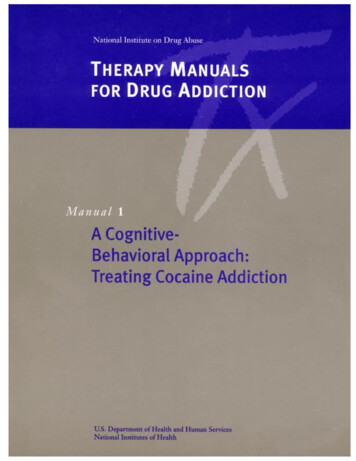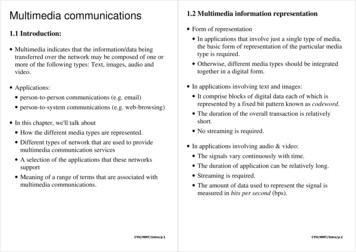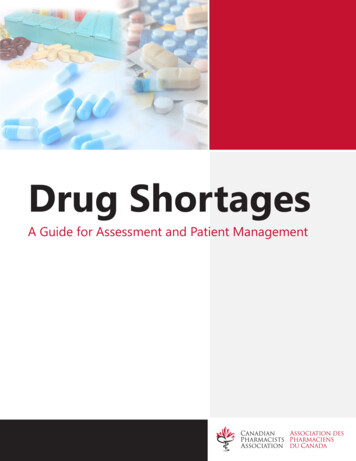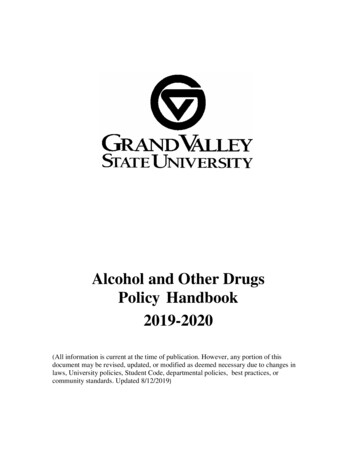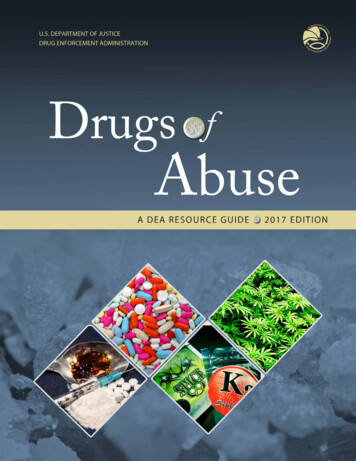
Transcription
Acquiring Editor: Paul PetraliaProject Editor: Susan FoxCover Design: Denise CraigPrepress: Kevin LuongLibrary of Congress Cataloging-in-Publication DataDrug abuse handbook / editor-in-chief, Steven B. Karch.p.cm.Includes bibliographical references.ISBN 0-8493-2637-0 (alk. paper)1. Drugs of abuse--Handbooks, manuals, etc. 2. Drug abuse-Handbooks, manuals, etc. 3. Forensic toxicology--Handbooks,manuals, etc. I. Karch, Steven B.RM316.D76 1997616.86--dc2197-45100CIPThis book contains information obtained from authentic and highly regarded sources. Reprinted material is quoted withpermission, and sources are indicated. A wide variety of references are listed. Reasonable efforts have been made to publishreliable data and information, but the author and the publisher cannot assume responsibility for the validity of all materials orfor the consequences of their use.Neither this book nor any part may be reproduced or transmitted in any form or by any means, electronic or mechanical,including photocopying, microfilming, and recording, or by any information storage or retrieval system, without priorpermission in writing from the publisher.All rights reserved. Authorization to photocopy items for internal or personal use, or the personal or internal use of specificclients, may be granted by CRC Press LLC, provided that .50 per page photocopied is paid directly to Copyright ClearanceCenter, 27 Congress Street, Salem, MA 01970 USA. The fee code for users of the Transactional Reporting Service is ISBN0-8493-2637-0/98/ 0.00 .50. The fee is subject to change without notice. For organizations that have been granted aphotocopy license by the CCC, a separate system of payment has been arranged.CRC Press LLC’s consent does not extend to copying for general distribution, for promotion, for creating new works, orfor resale. Specific permission must be obtained in writing from CRC Press LLC for such copying.Direct all inquiries to CRC Press LLC, 2000 Corporate Blvd., N.W., Boca Raton, Florida 33431.Trademark Notice: Product or cororate names may be trademarks or registered trademarks, and are used only foridentification and explanation, without intent to infringe. 1998 by CRC Press LLCNo claim to original U.S. Government worksInternational Standard Book Number 0-8493-2637-0Library of Congress Card Number 97-45100Printed in the United States of America 1 2 3 4 5 6 7 8 9 0Printed on acid-free paper
PREFACEIt is my hope that this book will be used both by scientists and the policymakers who determinewhere the research dollars are spent. Anyone who takes the time to read more than a few pagesof this Handbook will encounter quite a few surprises, some good and some bad. The goodnews is that during the last decade, a tremendous amount has been learned about abused drugs.The bad news is that progress has not been equally rapid on all fronts. Molecular biologists andneurochemists who, perhaps not coincidentally receive the lion’s share of federal funding, havemade breathtaking advances. They are tantalizingly close to characterizing the basic mechanisms of addiction. Progress has been somewhat less dramatic on other fronts.Testing workers for drugs has become a huge, competitive business. Market forces haveensured that the necessary research was done. Regulated urine drug testing is now a reliableand reasonably well-understood process. Yet, desperately needed studies to test the efficacy (asopposed to the accuracy) of workplace drug testing programs are not on the horizon, and westill do not know with any certainty whether the enormous amount of money being spent reallyhas an effect on worker absenteeism, accident rates, and productivity.In areas where government and industry share common interests, there has been impressiveprogress. Researchers interested in impairment testing have received sufficient funding tofinally place this discipline on firm scientific footing. But practical workplace applications forimpairment testing are hampered by the paucity of data relating blood, hair, sweat, and salivadrug concentrations with other workplace performance measures.The use of alternate testing matrices poses a daunting challenge. Until very recently,alternate approaches to workplace testing were not permitted. There was little governmentinterest, and no potential market in sight. With no money to be made, industry leaders saw noreason to invest in new technologies. Now it appears that pressure from private industry hasaltered government perceptions, and changes may be imminent. But a great deal of scienceremains to be done. In particular, basic pharamcokinetic research is needed to describe thedisposition of abused drugs in alternate specimens. Without such data, the utility of alternatespecimens is limited, and reliable interpretation of test results is nearly impossible.Farther away from university and government laboratories, at the bedside and at theautopsy table, the picture is not quite so rosy. SAMSHSA supported the development ofLAAM, the long acting methadone substitute, and funding has gone into improving methadone maintenance programs. But methadone clinics are not ivory towers, and controlledstudies with non-compliant patients are fiendishly difficult. Politicians intent on being “toughon drugs” have created a regulatory climate where control of treatment has largely been takenaway from physicians, and political considerations outweigh reasoned scientific judgment. Therecent suggestion by National Drug Control Policy Director Barry McCaffrey that physiciansbe allowed to prescribe methadone, may mark an important shift in the way our leaders addressthese problems.Even so, research into the medical management of drug users is not exactly a priority issue.One might suppose that given the very sophisticated techniques now available for therapeuticdrug monitoring, the kinetics of abused drugs would be well characterized. There are severalreasons why they have not. Discounting the fact that such projects have little commercialappeal, and seem not to be a priority for our government (even though most of the importantresearch has been done at the federally funded Addiction Research Center), the greatesthandicaps are ethical and political. Drug abusers take drugs in quantities that no Institutional 1998 by CRC Press LLC
Review Board would ever approve and that doctors would refuse to administer. Whether or notthe body metabolizes 50 mg of cocaine given intravenously the same way it manages 250 mgis, for the moment, at least, anyone’s guess. However, the results of recent studies from theAddiction Research Center suggest that chronic oral dosing with cocaine may allow researchersto simulate the high doses used on the street.Cocaine and heroin abuse claim the lives of more than 15,000 Americans every year, butno pathologist sits on the advisory board that passes on drug research grants, and there is nofederal funding for pathology or for pathologists interested in drug abuse. The sorry state ofthe DAWN report (Drug Abuse Warning Network) offers a hint of the importance ourgovernment accords to the investigation of drug-related deaths; results for 1995 were finallyreleased in May of 1997! Three-year-old epidemiologic data may be of some interest tohistorians, but it certainly is of little value to clinicians.At least the epidemiologic studies get funded. Lack of federal support means that a greatmany promising leads are being passed up. There is mounting evidence that chronic drug abuseproduces identifiable morphologic changes in the heart, brain, lungs, and liver. But there areno federal funds to support the studies needed to translate these preliminary observations intouseful diagnostic tools.Toxicologists studying postmortem materials have done no better than the pathologists.Technologic innovations in workplace testing and therapeutic drug monitoring now allow theroutine measurement of nanogram quantities of drugs in tissue obtained at autopsy, but theinterpretation of these measurements is not a straightforward process. Even though postmortem drug concentrations are frequently debated in court, research on the interpretation ofpostmortem drug levels consists of little more than a handful of case reports, published by afew dedicated researchers. During the last decade, more than 50,000 Americans have diedusing cocaine, but postmortem tissue levels have only been reported in a handful of cases.Even if the tissue levels were better characterized, tolerance occurs. It is impossible to speakof “lethal” and “non-lethal” cocaine and morphine concentrations because tolerant users maybe unaffected by levels that would be lethal in naive drug users. But, poorly informed physiciansand attorneys continue to ignore these subtleties, just as they continue to ignore the wealthof scientific knowledge that has been accumulated on the effects of alcohol, both in the livingand the dead. The same legal arguments are debated again and again, even though the sciencehas been very well worked out.Important research remains to be done, yet we have already learned a great deal. Unfortunately, that knowledge is not being shared effectively, not with the rest of the medicalcommunity, not with the courts, and certainly not with drug policy makers. If we can do abetter job of educating, then sometime in the not too distant future, we may be able to obtainthe support for the work that we know needs to be done. I hope this book helps in that process. 1998 by CRC Press LLC
THE EDITORDr. Karch received his bachelors degree from Brown University, did graduate work in cell biology and biophysics atStanford, and attended Tulane Medical School. He studiedneuropathology at the Barnard Baron Institue in London,and cardiac pathology at Stanford. During the 1970s, hewas a Medical Advisor for Bechtel in Southeast Asia. He isan Assistant Medical Examiner in San Francisco, where heconsults on cases of drug-related death. His textbook, ThePathology of Drug Abuse, is used around the world, and isgenerally considered the standard reference on the subject.He and his wife, Donna, live in Berkeley, California.Photo courtesy of Brandon White, Berkeley, California 1998 by CRC Press LLC
CONTRIBUTORSWilmo AndolloQuality Assurance OfficerDade County Medical ExaminerDepartmentToxicology LaboratoryMiami, FloridaJohn Baenziger, M.D.Director, Chemical PathologyDepartment of Pathology and LaboratoryMedicineIndiana University School of MedicineIndianapolis, IndianaJoanna BanberyThe Leeds Addiction UnitLeeds, U.K.Michael H. BaumannClincial Pharmacology SectionIntramural Research ProgramNational Institute on Drug AbuseNational Institutes of HealthBaltimore, MarylandMichael D. Bell, M.DAssociate Medical ExaminerDade County Medical Examiner OfficeMiami, FloridaNeal L. Benowitz, M.D.Professor of MedicineChief, Division of Clinical Pharmacologyand Experimental TherapeuticsUniversity of CaliforniaSan Francisco, CaliforniaJohn W. BojaDepartment of PharmacologyNortheastern Ohio UniversitiesCollege of MedicineRootstown, Ohio 1998 by CRC Press LLCJoseph P. Bono, MASupervisory ChemistDrug Enforcement AdministrationSpecial Testing and Research LaboratoryMcLean, VirginiaEdward B. BunkerNational Institute on Drug AbuseIntramural Research ProgramAddiction Research CenterBaltimore, MarylandAllen P. Burke, M.D.Department of Cardiovascular PathologyArmed Forces Institute of PathologyWashington, D.C.Donna M. Bush, Ph.D., D-ABFTDrug Testing Team LeaderDivision of Workplace ProgramsCenter for Substance Abuse PreventionSubstance Abuse and Mental HealthServices AdministrationWashington, D.C.J.C. Callaway, Ph.D.Department of Pharmaceutical ChemistryUniversity of KuopioKuopio, FinlandYale H. Caplan, Ph.D.National Scientific ServicesBaltimore, MarylandDon H. Catlin, M.D.Department of Molecular and MedicalPharmacologyDepartment of MedicineUCLA School of MedicineUniversity of CaliforniaLos Angeles, California
Edward J. Cone, Ph.D.Intramural Research ProgramNational lnstitute on Drug AbuseNational Institutes of HealthBaltimore, MarylandDennis J. CrouchCenter for Human ToxicologyUniversity of UtahSalt Lake City, UtahRoss C. CuneoDepartment of EndocrinolonologyDiabetes & Metabolic MedicineUnited and Medical and Dental School ofGuy’s and St. Thomas’ HospitalsLondon, U.K.Alan E. DavisDirector of ToxicologyLabOne, IncKansas City, KansasBjörn EkblomDepartment of Physiology andPharmacologyKarolinska InstituteStockholm, SwedenReginald V. FantNational Institute on Drug AbuseIntramural Research ProgramAddiction Research CenterBaltimore, MarylandAndrew Farb, M.D.Department of Cardiovascular PathologyArmed Forces Institute of PathologyWashington, D.C.Douglas FraserThe Leeds Addiction UnitLeeds, U.K.Bruce A. Goldberger, Ph.D.Director of Toxicology and AssistantProfessorUniversity of Florida College of MedicineGainesville, Florida 1998 by CRC Press LLCAlastair W.M. HayUniversity of LeedsResearch School of MedicineLeeds, U.K.Wm. Lee Hearn, Ph.D.Director of ToxicologyMetro Dade County Medical ExaminerDepartmentMiami, FloridaStephen J. Heishman, Ph.D.Clinical Pharmacology BranchDivision of Intramural ResearchNational Institute on Drug AbuseBaltimore, MarylandAnders HelanderDepartment of Clinical NeuroscienceKarolinska InstituteSt. Görans HospitalStockholm, SwedenBradford R. Hepler, Ph.D.Toxicology LaboratoryWayne County Medical ExaminerDetroit, MichiganMarilyn A. Huestis, Ph.D.Laboratory of Chemistry and DrugMetabolismAddiction Research CenterNational Institute on Drug AbuseBaltimore, MarylandDaniel S. Isenschmid, Ph.D.Toxicology LaboratoryWayne County Medical ExaminerDetroit, MichiganAmanda J. Jenkins, Ph.DIntramural Research ProgramNational lnstitute on Drug AbuseNational Institutes of HealthBaltimore, MarylandAlan Wayne JonesDepartment of Forensic ToxicologyUniversity HospitalLinköping, Sweden
Graham R. JonesOffice of the Chief Medical ExaminerEdmonton, Alberta, CanadaSteven B. Karch, M.D.Assistant Medical ExaminerCity and County of San FranciscoSan Francisco, CaliforniaThomas H. KellyDepartment of Behavioral ScienceCollege of MedicineUniversity of KentuckyLexington, KentuckyFrank D. Kolodgie, Ph.D.Department of Cardiovascular PathologyArmed Forces Institute of PathologyWashington, D.C.Barry LoganWashington State Toxicology LaboratoryDepartment of Laboratory MedicineUniversity of WashingtonSeattle, WashingtonChristopher S. MartinWestern Psychiatric Institute and ClinicDepartment of PsychiatryUniversity of Pittsburgh School of MedicinePittsburgh, PennsylvaniaDeborah C. MashDepartments of Neurology and Molecularand Cellular PharmacologyUniversity of Miami School of MedicineMiami, FloridaD.J. McKenna, Ph.D.Heffter Research InstituteSante Fe, New MexicoWilliam M. MeilDepartment of PharmacologyNortheastern Ohio UniversitiesCollege of MedicineRootstown, Ohio 1998 by CRC Press LLCStephen M. Mohaupt, MDUSC Institute of Psychiatry, Law, and theBehavioral SciencesLos Angeles, CaliforniaFlorabel G. Mullick, M.D.Department of Cardiovascular PathologyArmed Forces Institute of PathologyWashington, D.C.Jagat Narula, M.D., Ph.D.Harvard Medical Schooland Northeastern UniversityBoston, MassachusettsKent R. Olson, MDClinical Professor of Medicine, Pediatrics,and PharmacyUCSFMedical DirectorCalifornia Poison Control SystemSan Francisco General HospitalSan Francisco, CaliforniaMichael Peat, Ph.D.Executive Vice President, ToxicologyLabOne, IncKansas City, KansasWallace B. PickworthNational Institute on Drug AbuseIntramural Research ProgramAddiction Research CenterBaltimore, MarylandDerrick J. PounderDepartment of Forensic MedicineUniversity of DundeeScotland, U.K.Kenzie L. Preston, Ph.D.Intramural Research ProgramNational Institute on Drug AbuseJohns Hopkins University School ofMedicineBaltimore, MarylandDuncan RaistrickThe Leeds Addiction UnitLeeds, U.K.
Brett Roth, MDPostdoctoral FellowDivision of Clinical Pharmacology andToxicologyUniversity of CaliforniaSan Francisco, CaliforniaRichard B. RothmanClinical Psychopharmacology SectionIntramural Research ProgramNational Institute on Drug AbuseNational Institutes of HealthBaltimore, MarylandSteven St. Clair, M.D., M.P.H.Executive DirectorAmerican Association of Medical ReviewOfficersDurham, North CarolinaWilhelm SchänzerGerman Sports University of CologneInstitute of BiochemistryCologne, GermanyJordi SeguraInstitut Municipal d’ Investigació Mèdica,IMIMDepartament de Farmacologia i ToxicologiaBarcelona, SpainDavid W. SelfDivision of Molecular PsychiatryYale University School of Medicine andConnecticut Mental Health CenterNew Haven, ConnecticutTheodore F. ShultsQuadrangle ResearchResearch Triangle ParkDurham, North CarolinaDonna R. Smith, Ph.D.Senior Vice President, Planning &ImplementationSubstance Abuse Management, Inc.Boca Raton, Florida 1998 by CRC Press LLCPeter SönksenProfessorDepartment of EndocrinolonologyDiabetes & Metabolic MedicineUnited and Medical and Dental School ofGuy’s and St. Thomas’ HospitalsLondon, U.K.Julie K. Staley, Ph.D.Department of NeurologyUniversity of Miami School of MedicineMiami, FloridaRichard C. TaylorClinical Pharmacology BranchDivision of Intramural ResearchNational Institute on Drug AbuseBaltimore, MarylandRafael de la Torre, PharmDDepartment of Pharmacology andToxicologyInstitute Municipal d’Investigació MèdicoBarcelona, SpainRenu Virmani, M.D.Department of Cardiovascular PathologyArmed Forces Institute of PathologyWashington, D.C.Jennifer D. WallaceDepartment of EndocrinolonologyDiabetes & Metabolic MedicineUnited and Medical and Dental School ofGuy’s and St. Thomas’ HospitalsLondon, U.K.H. Chip WallsUniversity of MiamiDepartment of PathologyForensic Toxicology LaboratoryMiami, FloridaJ. Michael Walsh, Ph.D.The Walsh Group, P.A.Bethesda, Maryland
Sharon L. Walsh, Ph.D.Johns Hopkins University School ofMedicineBaltimore, MarylandCharles V. Wetli, MDSuffolk Country Medical ExaminerHappauge, New YorkRuth E. Winecker, Ph.D.Deputy Chief ToxicologistOffice of the Chief Medical ExaminerChapel Hill, North Carolina 1998 by CRC Press LLCKim WolffNational Addiction CentreInstitute of PsychiatryUniversity of LondonLondon, EnglandShoshana Zevin, MDPostdoctoral FellowDivision of Clinical Pharmacology andToxicologyUniversity of CaliforniaSan Francisco, California
DEDICATIONFor RBTACKNOWLEDGMENTSAll of the section editors deserve a special note of thanks. Orchestrating 80 contributors is noeasy task, and the work was particularly hard for some. My special thanks to Lee Hearn andYale Caplan. Each of their chapters could have been separate books, and the effort theyexpended shows. Thanks also to the management at CRC Press (including Paul Petralia) forhaving the vision to undertake the project in the first place, and to Susan Fox for putting it alltogether. Sara Morabito gave valuable help with the manuscripts, and Bill Keach remains theworld's greatest fact checker. I hope CRC is satisfied with the result. Hardwin Meade andRoger Wincle continue to make their own unique contributions. And my wife, Donna, whocontinues to be supportive. 1998 by CRC Press LLC
TABLE OF CONTENTS12Criminalistics—Introduction to Controlled Substances Joseph P. Bono3Pharmacokinetics: Drug Absorption, Distribution, and EliminationAmanda J. Jenkins, and Edward J. Cone4Pharmacodynamics Edited by Stephen J. Heishman4.1 Effects of Abused Drugs on Human Performance: Laboratory AssessmentStephen J. Heishman4.2 Performance Measures of Behavioral Impairment in Applied SettingsThomas H. Kelly, Richard C. Taylor, Stephen J. Heishman, andDennis J. Crouch4.3 Effects of Abused Drugs on Pupillary Size and the Light ReflexWallace B. Pickworth, Reginald V. Fant, and Edward B. Bunker4.4 Evaluating Abuse Liability: Methods and Predictive ValueKenzie L. Preston, and Sharon L. Walsh5Alcohol Edited by Christopher S. Martin5.1 Measuring Acute Alcohol Impairment Christopher S. Martin5.2 Measuring Blood-Alcohol Cencentration for Clinical and Forensic PurposesA. Wayne Jones and Derrick J. Pounder5.3 Measuring Alcohol Postmortem Derrick J. Pounder and A. Wayne Jones5.4 Biochemical Tests for Acute and Chronic Alcohol IngestionAnders Helander and Alan Wayne Jones6Neurochemistry of Drug Abuse Edited by Deborah C. Mash andJulie K. Staley6.1 The Dopamine Transporter and Addiction John W. Boja andWilliam M. Meil6.2 Neuropsychiatric Consequences of Chronic Cocaine AbuseDeborah C. Mash6.3 Neurochemical Adaptations and Cocaine Dependence Julie K. Staley6.4 The Neurobiology of Relapse David W. SelfPathology of Drug Abuse Edited by Charles V. Wetli2.1 Preliminary Observations Charles V. Wetli2.2 Diseases of the Heart2.2.1 Techniques for Examination of the Heart Renu Virmani,Allen P. Burke, and Andrew Farb2.2.2 Myocardial Alterations in Drug Abusers Steven B. Karch2.2.3 Endocarditis Michael D. Bell2.2.4 Vascular Effects of Substance Abuse Frank D. Kolodgie,Allen Burke, Jagat Narula, Florabel G. Mullick,and Renu Virmani2.3 Lung Disease Michael D. Bell2.4 Disorders of the Central Nervous System Michael D. Bell2.5 Miscellaneous Complications Charles V. Wetli 1998 by CRC Press LLC
6.5 Serotonergic Dysfunction During Cocaine Withdrawal: Implications forCocaine-Induced Depression Michael H. Baumann andRichard B. Rothman6.6 Neurochemistry of Psychedelic Drugs J.C. Callaway and D.J. McKenna7Addiction Medicine Edited by Kim Wolff7.1 The Principles of Addiction Medicine Duncan Raistrick7.2 Substitute Prescribing Kim Wolff7.2.1.6 Buprenorphine Maintenance Prescribing Douglas Fraser7.3 Treatment of Withdrawal Syndromes Joanna Banbery7.4 Replacement Prescribing Kim Wolff7.4.1 Opiate Specific Prescribing Douglas Fraser7.5 Management of Comorbidity Duncan Raistrick7.6 Toxicologic Issues Alastair W.M. Hay8Medical Complications of Drug Abuse Edited by Neal L. Benowitz8.1 Drug-Related Syndromes Shoshana Zevin and Neal L. Benowitz8.2 Emergency Management of Drug Abuse-Related DisordersBrett A. Roth, Neal L. Benowitz, and Kent R. Olson9Sports Edited by Jordi Segura9.1 Introduction Jordi Segura9.2 Specific Agents Rafael de la Torre9.3 Anabolic Androgenic Steroids Don H. Catlin9.4 Detection of Exogenous Anabolic Androgenic SteroidsWilhelm Schänzer9.5 Growth Hormone Abuse in Elite Athletes Ross C. Cuneo,Jennifer D. Wallace, and Peter Sönksen9.6 Erythropoietin Björn Ekblom9.7 Summary of International Olympic Committee Regulations Jordi Segura10 Workplace Testing Edited by Yale H. Caplan10.1 Development and Scope of Regulated Testing J. Michael Walsh10.2 Laboratory Accreditation Programs10.2.1 An Overview of the Mandatory Guidelines for Federal WorkplaceDrug Testing Programs Donna M. Bush10.2.2 The College of American Pathologists Voluntary LaboratoryAccreditation Program John Baenziger10.3 Analytical Considerations and Approaches for Drugs Michael Peat andAlan E. Davis10.4 Urine Specimen Suitability for Drug Testing Ruth E. Winecker andBruce A. Goldberger10.5 The Role of the Medical Review Officer: Current Issues Steven St. Clair10.6 Alternative Drugs, Specimens, and Approaches for Non-RegulatedDrug Testing Dennis Crouch10.7 Implementation of Alcohol Testing: General Considerations andProcesses Donna R. Smith11 Alternative Testing Matrices Marilyn A. Huestis and Edward J. Cone12 Postmortem Toxicology Edited by Wm. Lee Hearn12.1 Introduction of Postmortem ToxicologyH. Chip Walls 1998 by CRC Press LLCWm. Lee Hearn and
12.2 Specimen Selection, Collection, Preservation, and SecurityBradford R. Hepler and Daniel S. Isenschmid12.3 Common Methods in Postmortem Toxicology Wm. Lee Hearn andH. Chip Walls12.4 Strategies for Postmortem Toxicology Investigation Wm. Lee Hearn andH. Chip Walls12.5 Quality Assurance in Postmortem Toxicology Wilmo Andollo12.6 Interpretation of Postmortem Drug Levels Graham R. Jones13 Drug Law13.1 Current Legal Issues of Workplace Drug Testing Theodore F. Shults13.2 DUI Defenses Alan Wayne Jones and Barry Logan13.3 Fetal Rights Stephen M. MohauptAppendicesIaGlossary of Terms in Forensic Toxicology Chip WallsIb Common Abbreviations Chip WallsIcReferences for Methods of Drug Quantitative AnalysisIISample Calculations Barry K. Logan and Alan Wayne JonesIII Predicted Normal Heart Weight (g) as a Function of Body Height 1998 by CRC Press LLC
CHAPTER 1CRIMINALISTICS—INTRODUCTION TOCONTROLLED SUBSTANCESJOSEPH P. BONO, MASUPERVISORY CHEMIST, DRUG ENFORCEMENT ADMINISTRATION, SPECIAL TESTINGRESEARCH LABORATORY, MCLEAN, VIRGINIATABLE OF CONTENTS1.11.21.31.4Definition and Scheduling of Controlled SubstancesScheduling of Controlled SubstancesControlled Substance Analogue Enforcement Act of 1986Controlled Substances1.4.1 Heroin1.4.1.1 Heroin Sources by Region1.4.1.2 Isolation of Morphine and Heroin Production1.4.2 Cocaine1.4.2.1 Sources of Cocaine1.4.2.2 Historical Considerations1.4.2.3 Isolation and Purification1.4.2.4 Conversion to “Crack”1.4.2.5 Other Coca Alkaloids1.4.2.6 Cocaine Adulterants1.4.3 Marijuana1.4.3.1 History and Terminology1.4.3.2 Laboratory Analysis1.4.4 Peyote1.4.5 Psilocybin Mushrooms1.4.6 Lysergic Acid Diethylamide (LSD)1.4.7 Phencyclidine (PCP)1.4.8 Fentanyl1.4.9 Phenethylamines1.4.10 Methcathinone (CAT)1.4.11 Catha Edulis (KHAT)1.4.12 Anabolic Steroids1.4.12.1 Regulatory History1.4.12.2 Structure Activity Relationship1.4.12.3 Forensic Analysis1.5 Legitimate Pharmaceutical Preparations1.5.1 Benzodiazepines1.5.2 Other Central Nervous System Depressants 1998 by CRC Press LLCAND
1.61.71.81.91.5.3 Narcotic Analgesics1.5.4 Central Nervous System Stimulants1.5.5 Identifying Generic ProductsUnique Identify Factors1.6.1 Packaging Logos1.6.2 Tablet Markings and Capsule Imprints1.6.3 Blotter Paper LSDAnalyzing Drugs in the Forensic Science Laboratory1.7.1 Screening Tests1.7.1.1 Physical Characteristics1.7.1.2 Color Tests1.7.1.3 Thin Layer Chromatography1.7.2 Confirmatory Chemical Tests1.7.2.1 Microcrystal Identifications1.7.2.2 Gas Chromatography1.7.2.3 High Performance Liquid Chromatography (HPLC)1.7.2.4 Capillary Electrophoresis (CE)1.7.2.5 Infrared Spectrophotometry (IR)1.7.2.6 Gas Chromatography/Mass Spectroscopy (GC/MS)1.7.2.7 Nuclear Magnetic Resonance (NMR) Spectroscopy1.7.3 Controlled Substances Examinations1.7.3.1 Identifying and Quantitating Controlled Substances1.7.3.2 Identifying Adulterants and Diluents1.7.3.3 Quantitating Controlled Substances1.7.3.4 Reference StandardsComparative Analysis1.8.1 Determining Commonality of Source1.8.2 Comparing Heroin Exhibits1.8.3 Comparing Cocaine ExhibitsClandestine Laboratories1.9.1 Safety Concerns1.9.2 Commonly Encountered Chemicals in the ClandestineLaboratory1.9.3 Tables of Controlled Substances1.9.3.1 Generalized List by Category of Physiological Effectsand Medical Uses of Controlled Substances1.9.3.2 Listing of Controlled Substances by Schedule Number1.1 DEFINITION AND SCHEDULING OF CONTROLLED SUBSTANCESA “controlled substance” is a drug or substance of which the use, sale, or distribution isregulated by the federal government or a state government entity. These controlled substancesare listed specifically or by classification on the federal level in the Controlled Substances Act(CSA) or in Part 1308 of the Code of Federal Regulations. The purpose of the CSA is tominimize the quantity of useable substances available to those who are likely to abuse them.At the same time, the CSA provides for the legitimate medical, scientific, and industrial needsof these substances in the U.S. 1998 by CRC Press LLC
1.2 SCHEDULING OF CONTROLLED SUBSTANCESEight factors are considered when determining whether or not to schedule a drug as acontrolled substance:1.2.3.4.5.6.7.8.Actual or relative potential for abuse.Scientific evidence of pharmacological effect.State of current scientific knowledge.History of current pattern of abuse.Scope, duration, and significance of abuse.Risk to the public health.Psychic or physiological dependence liability.Immediate precursor.The definition of potential for abuse is based upon an individual taking a drug of his ownvolition in sufficient amounts to cause a health hazard to himself or to others in the community.Data is then collected to evaluate three factors: (1) actual abuse of the drug; (2) the clandestinemanufacture of the drug; (3) trafficking and diversion of the drug or its precursors fromlegitimate channels into clandestine operations. Pre-clinical abuse liability studies are thenconducted on animals to evaluate physiological responses to the drug. At this point, clinicalabuse liability studies can be conducted with human subjects, which evaluate preference studiesand epidemiology.Accumulating scientific evidence of a drug’s pharmacological effects involves examiningthe scientific data concerning whether the drug elicits a stimulant, depressant, narcotic, orhallucinogenic response. A determination can then be made as to how closely the pharmacology of the drug resembles that of other drugs that are already controlled.Evidence is also accumulated about the scientific data on the physical and chemicalproperties of the drug. This can include determining which salts and isomers are possible andwhich are available. There is also a concern for the ease of detection and identification usinganalytical chemistry. Since many controlled substances have the potential for clandestinesynthesis, there is a requirement for evaluating precursors, possible synthetic routes, andtheoretical yields in these syntheses. At this phase of the evaluation, medical uses are alsoevaluated.The next three factors—(1) history and patterns of abuse; (2) scope, duration, andsignificance of abuse; and (3) risks to public health—all involve sociological and medicalconsiderations. The results of these studies focus on data collection and population studies.Psychic and physiological dependence liability studies must be satisfied for a substance to beplaced into Schedules II through V. This specific finding is not necessary to place a drug intoSchedule I. A practical problem here is that it is not always easy to prove a development ofdependen
Drug abuse handbook / editor-in-chief, Steven B. Karch. p. cm. Includes bibliographical references. ISBN 0-8493-2637-0 (alk. paper) 1. Drugs of abuse--Handbooks, manuals, etc. 2. Drug abuse- .


